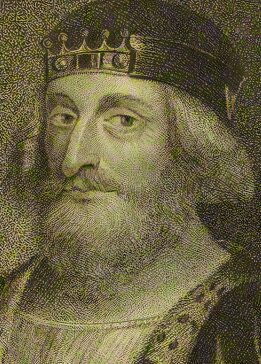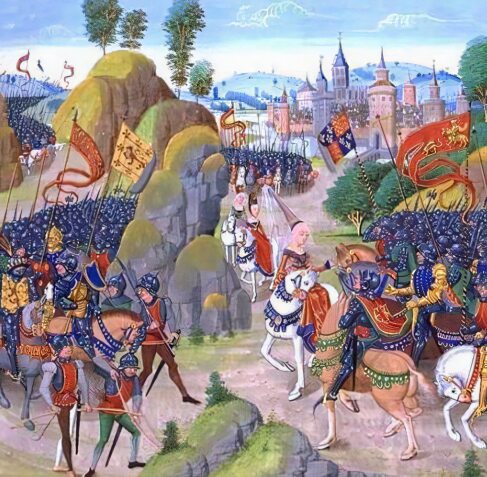1329-1371
David Bruce, the only son of Robert the Bruce and his second wife Elizabeth de Burgh was born on 5th March, 1324 at Dunfermline, Fife.
By the terms of the Treaty of Northampton, David was married at the age of four on 17 July 1328 to Joan of England, theseven year old daughter of King Edward II and Isabella of France. Despite their marriage lasting thirty-four years, it was childless and apparently loveless.
David II
On the demise of the great Robert the Bruce in 1329, David, aged five at the time, was duly proclaimed King of Scots and was crowned at Scone Abbey in November 1331. Edward Balliol, the son of the exiled King John Balliol siezing the opportunity a minority presented, invaded Scotland with an English army and achieved victory over a Scottish army at Dupplin Moor when the regent, Robert's Bruce's nephew, Donald, Earl of Mar was killed in battle.
Balliol was duly crowned Edward, King of Scots at Scone Abbey. In 1332, at a meeting in Dumbarton Castle, Sir Andrew Murray was elected Guardian of Scotland by Scots who adhered to Robert the Bruce's young son, David II. The young David and his wife Joan were promptly sent to France for their greater safety. They arrived at Boulogne-sur-Mer in May 1334, where they were received by Joan's cousin, King Philip VI of France, the young couple resided at Château Gaillard at Les Andelys during their stay in France. Murray was later captured and imprisoned at Durham.
Edward III, allied to Balliol, laid siege to the border town of Berwick, The Scots, led by the new regent, Sir Archibald Douglas, met EdwardIII in battle at Halidon Hill, in Northumberland on July 19, 1333, a decisive English victory where Douglas was slain.
David II was eventually reinstated as Scotland's sovereign on the flight of Edward Balliol in 1336. The new King landed at Inverbervie in Kincardineshire on 2 June 1341.
David bore deep suspicions of his nephew, Robert Stewart, who was actually older than himself and had prior to his birth been declared the heir of Robert the Bruce. In response to an appeal for help from Phillip VI of France, in an uneasy alliance, the pair invaded England, where they jointly encountered an English army at The Battle of Neville's Cross in Northumberland.
Battle of Neville's Cross
The battle progressed badly for the Scots, as their position grew more dangerous, Robert Stewart panicked and fled the battlefield, but David displayed himself a true son of Robert the Bruce, fighting on with valour, despite having two arrows in his body.
He was taken captive by Sir John Copeland, David had initially managed to escape. However, legend records that while he was hiding under a bridge over the nearby River Browney, his reflection was spotted in the water by English soldiers out searching for him. He was transported to Calais and delivered to King Edward III. King David was imprisoned at Odiham Castle in Hampshire from 1346 to 1357. After eleven long years, he was released in return for a ransom of 100,000 marks.
The Scots continued the struggle, receiving French aid. Enraged, Edward III marched north into Scotland with an army. The crushed Scots finally submitted and agreed to pay a ransom of a hundred thousand pounds for the return of their captive king.
Weary of his English captivity, David Bruce came to a compromise with his captor Edward III, in an agreement frowned upon by the Scots and considered as a betrayal of all his renowned father had fought so long and hard for, he offered the English King his homage and his throne if he died childless, in return for his freedom. In 1363 David, who was now on cordial terms with King Edward III, proposed that Lionel Duke of Clarence, the second surviving son of the English king should succeed to the Scottish throne in return for the cancellation of the ransom. The arrangement did little to improve his relationship with his nephew, the future Robert II, and was repudiated by the Scottish Parliament.
David II did not live up to his early promise, Robert the Bruce proved a hard act to follow. David was extravagant and pleasure-loving, the Scots tolerated him because he was his father's son, but he failed to evoke their love or loyalty in the way, his father had done.
He remarried around 20th February 1364, to Margaret Drummond, widow of Sir John Logie, and daughter of Sir Malcolm Drummond. He divorced her on about 20th March 1370. They had no issue. Margaret travelled to Avignon and made a successful appeal to the Pope to reverse the sentence of divorce.
After a long reign, David died at Edinburgh Castle in February 1371, the last of the House of Bruce, he was buried at Holyrood Abbey. At the time of his death, David was planning to marry his mistress, Agnes Dunbar, the niece of Agnes Randolph, who was known as Black Agnes. He was succeeded by his nephew, Robert II, the first of the Stewart dynasty.
Elizabeth de Burgh PreviousNext Joan of England
